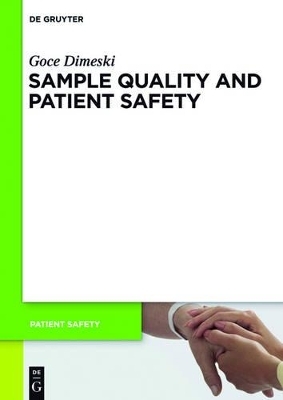
Sample quality and Patient Safety
Seiten
2019
De Gruyter (Verlag)
978-3-11-036817-8 (ISBN)
De Gruyter (Verlag)
978-3-11-036817-8 (ISBN)
- Titel wird leider nicht erscheinen
- Artikel merken
lt;p>New Series: Patient Safety
There is a large variety of factorscontributing or influencing sample quality and components that may be present in samples either introduced (exogenous) or those present in the sample as result of clinical changes (endogenous) "interferents" leading to inaccurate results. Insufficient attention has been placed in promoting the need to improve knowledge by pathology/medical laboratory experts on the range and extent of their influence. As pathology data influences on the average 70% medical decisions with admission, diagnosis and discharge there needs to be greater effort applied from pathology providers to aid clinicians in providing more accurate results and improved patient outcomes, maximizing patient safety.
Recognition and identification knowledge or suitable reference source such as this book would be a step in the right direction to reduce patient risks.
Sample quality can be influenced by numerous pre-analytical factors starting from patient preparation (e.g. fasting), collection process, choice of collection devises which includes needle size, collection vessel (e.g. anticoagulant choice, anticoagulant effects), sample processing and sample storage.
Medical errors do not only occur in the laboratory, but pose a direct threat to patient safety. The clinical laboratory is an integral part of care, and the results of analytics are an essential component of informed decision-making for clinicians. Efforts to avoid laboratory errors, especially minimizing pre- and postanalytical errors, are in the responsibility of laboratory professionals.
The new handbook series with the international known editors Oswald Sonntag and Mario Plebani fills a vacancy in the relevant and promising area of patient safety and quality assurance.
There is a large variety of factorscontributing or influencing sample quality and components that may be present in samples either introduced (exogenous) or those present in the sample as result of clinical changes (endogenous) "interferents" leading to inaccurate results. Insufficient attention has been placed in promoting the need to improve knowledge by pathology/medical laboratory experts on the range and extent of their influence. As pathology data influences on the average 70% medical decisions with admission, diagnosis and discharge there needs to be greater effort applied from pathology providers to aid clinicians in providing more accurate results and improved patient outcomes, maximizing patient safety.
Recognition and identification knowledge or suitable reference source such as this book would be a step in the right direction to reduce patient risks.
Sample quality can be influenced by numerous pre-analytical factors starting from patient preparation (e.g. fasting), collection process, choice of collection devises which includes needle size, collection vessel (e.g. anticoagulant choice, anticoagulant effects), sample processing and sample storage.
Goce Dimeski, Princess Alexandra Hospital, Brisbane, Australia.
| Erscheint lt. Verlag | 15.5.2019 |
|---|---|
| Reihe/Serie | Patient Safety ; 13 |
| Zusatzinfo | 15 schw.-w. Abb., 10 schw.-w. Tab. |
| Verlagsort | Berlin |
| Sprache | englisch |
| Maße | 170 x 240 mm |
| Einbandart | kartoniert |
| Themenwelt | Medizin / Pharmazie ► Medizinische Fachgebiete ► Laboratoriumsmedizin |
| Medizin / Pharmazie ► Medizinische Fachgebiete ► Mikrobiologie / Infektologie / Reisemedizin | |
| Studium ► 2. Studienabschnitt (Klinik) ► Klinische Chemie / Labordiagnostik | |
| Schlagworte | Patienten • Patientensicherheit |
| ISBN-10 | 3-11-036817-X / 311036817X |
| ISBN-13 | 978-3-11-036817-8 / 9783110368178 |
| Zustand | Neuware |
| Haben Sie eine Frage zum Produkt? |
Mehr entdecken
aus dem Bereich
aus dem Bereich
Lehrbuch zur Laboratoriumsmedizin, klinischen Chemie und Hämatologie
Buch | Softcover (2018)
De Gruyter (Verlag)
CHF 76,90


